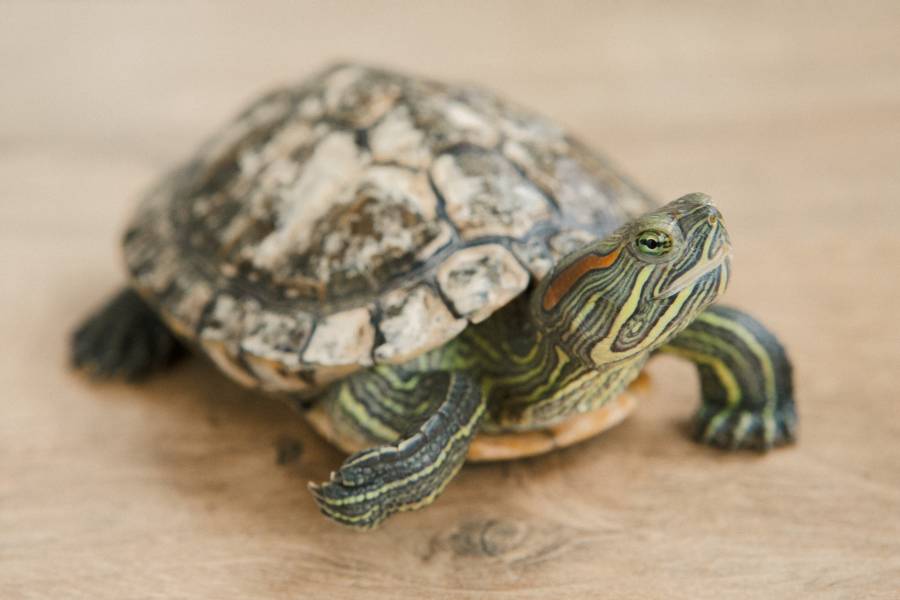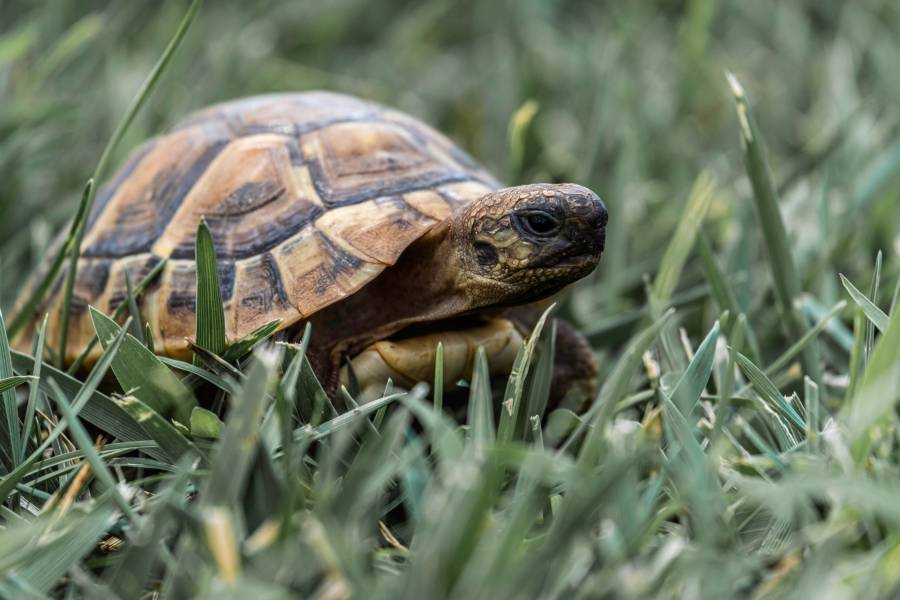Quick Navigation
Having an intelligent pet that learns quickly is what every owner can ask for!

Before you get a turtle, you will always have more questions about its intelligence.
We all want a pet that can be trained quickly and make it easy to teach them tricks.
How Smart Are Turtles?
1. Turtle’s Brain
We can measure a turtle’s level of smartness by studying its brain.
A turtle’s brain is tiny compared to other animals, like dogs or cats.
The size of a turtle’s brain is approximately 1/10th of its body weight.
But still, the average size of a turtle’s brain is only around 2-3 grams.
That is less than one ounce in weight.
A turtle’s brain does not grow any larger after birth.
It stays at this exact size until adulthood.
It consists of the cerebrum, the cerebellum, and the medulla oblongata.
These parts work together as a whole to control the senses and movement.
The cerebrum is responsible for maintaining sensory input from the eyes and ears.
It also controls balance and coordination.
And finally, the medulla oblongatas controls breathing and heart rate.
A turtle’s brain works on the “divide and conquer” principle.
When a turtle wants to do something, it senses to detect where it is and what is happening around it.
He then divides his attention between these different things.
For example, if he sees a predator approaching him, he will focus on that threat.
If there is food nearby, he will pay attention to that.
If he hears a noise, he will focus on it.
By doing so, he can keep track of everything happening around him.
2. Mental Capabilities
Some experts believe that turtles have an IQ of 10, while others say their intelligence level is closer to 3.
Some scientists think that their brains are similar to those of fish.
They believe that turtles can process information quickly because they have a lot of neurons.
There are over a million neurons in the human brain.
While a turtle may not have as many neurons as us, they have a higher density.
So, they are smarter than we are.
3. Turtle’s Memory
Turtles are smart little creatures because they are very good at remembering things.
They can memorize thousands of facts about their surroundings.
At the same time, they can find their way home after being separated from their family.
They can even recognize themselves in a mirror.
Turtles can also remember where they buried their food, which way to go home, and how many times they fell into a hole.
Also, what makes turtles smart is that their shells have a unique scent that helps the turtle recognize their owner.
The scent also helps the turtle to find food.
When the turtle finds food, it will rub the shell on the ground to transfer the scent to the food.
It explains why turtles are smart and not dumb as people think.
If a turtle loses its owner, it may not know what happened to them.
If this occurs, the turtle will search for a new home.
They will look for someone who has similar scents.
A turtle will only stay with one person at a time.
They will not accept another person into their home until they know they are not intruders.
Turtles can remember things for years.
They can remember the exact location of a meal they ate last week.
They can remember where they were born and lived before moving into a new home and who their parents are.
It has been proven that turtles have good memories.
They can remember where and when they were born, the names of family members, and they can retain the sounds of their names.
They can also remember the sound of their mother calling out to them.

4. Turtle Trainability
Turtles are known for being slow-moving creatures.
However, they can be trained to walk on a leash, swim, climb stairs, and even fetch with balls.
They also enjoy learning new tricks.
Some people believe that turtles are smarter than dogs.
It is because they are capable of learning by observing others.
Turtles can learn how to open doors by using their flippers.
If you put food inside the door, then the turtle will use its shell to open it.
There are many ways to teach your turtle how to behave.
For example, if you want your turtle to get used to walking on a leash, you could start by putting them in a small aquarium.
You would need to make sure that there was enough room so that your pet could move around freely.
Then, you should place the aquarium next to your couch.
Your pet will soon realize walking on a leash is safe.
If you want your turtle to learn other behaviors, such as playing fetch, you could try teaching it through positive reinforcement.
You can reward your pet when they do something right to reinforce a good habit.
When you feed your turtle on a schedule, it can also train itself to remember when it’s time to eat.
So don’t be surprised when your turtle is already looking at you or is waiting near its food bowl when it’s eating time!
5. Problem Solving
Turtles are smart in that they can use their brains to solve problems to be more successful in their environment.
Turtles’ most common problems are getting stuck in the mud, becoming trapped under rocks, and falling off ledges.
In these situations, they must figure out a way to escape.
They do this by digging tunnels, climbing trees, using vines, or swimming away.
In addition, turtles can locate and consume food items by using their sense of smell.
They can also find shelter from predators and other dangers by using their ability to detect threats.
6. Learning Abilities
Turtles have an excellent memory.
They remember things such as where they live, who their parents are, and where they last ate.
They can learn new behaviors quickly.
Turtle learning is pretty simple.
The turtle simply has to observe its environment and then use that information to decide where it wants to go next.
For example, if there’s an obstacle in front of them, they’ll move around it or try to get over it.
They’ll usually choose to stay put if there isn’t anything in their way.
It is why turtles are often seen basking in the sun.
It helps them absorb more sunlight which gives them energy.
But they may avoid something by changing direction if something comes into their path.
This is called “avoidance.”
When a turtle learns something new, it remembers it for life.
It doesn’t forget things like humans do.
The turtle uses its memory to help it navigate through its surroundings.
So, it knows what to do when encountering a similar situation later.
It is great to prove that turtles are indeed smart reptiles.
7. Communication
Like most reptiles, turtles communicate with each other using sounds.
It makes these creatures smart.
These sounds include hissing, growling, squeaking, and chirping.
There are two main types of communication.
One is visual communication, and the other is vocal communication.
Visual Communication
A turtle can see another turtle from up to 50 meters away.
The eyes of a turtle are located on top of its head.
Their pupils are small and round, allowing the animal to focus at different distances.
A turtle also has eyelids that protect its eyes from dust and dirt.
Vocal Communication
Turtles produce sounds to warn others of danger.
These sounds include grunts, squeals, hisses, honks, and growls.
Smart Turtle Breeds
There are specific turtle breeds that are inherently smart such as North American wood turtles, box turtles, and red-eared sliders.
The North American wood turtles are considered the smartest turtle species because they can remember how to go through mazes even when they haven’t been there for a long time.
Box turtles have a good memory and can remember their experiences, where they live, and their friends.
Meanwhile, red-eared sliders are smart in their particular way.
They respond to specific commands, especially when they are rewarded with treats.
Red-eared turtles are also smart enough to also get out of their aquarium.
So if you want to get a smart turtle, you may want to consider these three breeds.
Conclusion
No one can measure the exact IQ of a turtle, but scientists have discovered some ways to predict the level of smartness of a turtle.
The above are some practical measures that test the turtle’s intelligence.
These tests estimate how well the turtle can solve problems, think, learn, and communicate.

Purrfect n’ Pawesome is the brainchild of Amanda, who has been into researching and writing about pets to help other pet parents in nurturing their adorable pets. Currently, she runs Purrfect n’ Pawesome along with her team of experienced and dedicated pet experts. Along with being an awesome writer and entrepreneur, Amanda is a cat mom to two innocently spoiled cats, Balanca and Scruffy.
She has been writing about pet care and nurturing and wants to share her readers’ experiences, learnings, and knowledge.
Over the years, she had the opportunity to work with various pet owners having multiple breeds, and that exposure gave her experience and the lessons of a lifetime.
Her family, her entire universe revolves around her two cats, who give her endless support and inspiration to move ahead with her objectives in life. Amanda is a live example of a balanced approach to all parenthood questions we all face in life.
